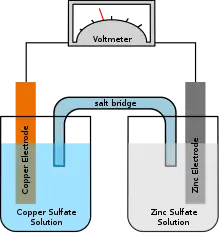Aluminium–air battery
Aluminium–air batteries (Al–air batteries) produce electricity from the reaction of oxygen in the air with aluminium. They have one of the highest energy densities of all batteries, but they are not widely used because of problems with high anode cost and byproduct removal when using traditional electrolytes. This has restricted their use to mainly military applications. However, an electric vehicle with aluminium batteries has the potential for up to eight times the range of a lithium-ion battery with a significantly lower total weight.[1]
| Specific energy | 1300 (practical), 6000/8000 (theoretical) W·h/kg[1] |
|---|---|
| Energy density | N/A |
| Specific power | 200 W/kg |
| Nominal cell voltage | 1.2 V |
Aluminium–air batteries are primary cells, i.e., non-rechargeable. Once the aluminium anode is consumed by its reaction with atmospheric oxygen at a cathode immersed in a water-based electrolyte to form hydrated aluminium oxide, the battery will no longer produce electricity. However, it is possible to mechanically recharge the battery with new aluminium anodes made from recycling the hydrated aluminium oxide. Such recycling would be essential if aluminium–air batteries were to be widely adopted.
Aluminium-powered vehicles have been under discussion for some decades.[2] Hybridisation mitigates the costs, and in 1989 road tests of a hybridised aluminium–air/lead–acid battery in an electric vehicle were reported.[3] An aluminium-powered plug-in hybrid minivan was demonstrated in Ontario in 1990.[4]
In March 2013, Phinergy[5] released a video demonstration of an electric car using aluminium–air cells driven 330 km using a special cathode and potassium hydroxide.[6] On May 27, 2013, the Israeli channel 10 evening news broadcast showed a car with Phinergy battery in the back, claiming 2,000 kilometres (1,200 mi) range before replacement of the aluminum anodes is necessary.[7]
Electrochemistry
The anode oxidation half-reaction is Al + 3OH−
→ Al(OH)
3 + 3e− −2.31 V.
The cathode reduction half-reaction is O
2 + 2H
2O + 4e− → 4OH−
+0.40 V.
The total reaction is 4Al + 3O
2 + 6H
2O → 4Al(OH)
3 +2.71 V.
About 1.2 volts potential difference is created by these reactions and is achievable in practice when potassium hydroxide is used as the electrolyte. Saltwater electrolyte achieves approximately 0.7 volts per cell.
The specific voltage of the cell can vary in dependence of the composition of the electrolyte as well as the structure and materials of the cathode.
Commercialization
Issues
Aluminium as a "fuel" for vehicles has been studied by Yang and Knickle.[1] In 2002, they concluded:
The Al/air battery system can generate enough energy and power for driving ranges and acceleration similar to gasoline powered cars...the cost of aluminium as an anode can be as low as US$ 1.1/kg as long as the reaction product is recycled. The total fuel efficiency during the cycle process in Al/air electric vehicles (EVs) can be 15% (present stage) or 20% (projected), comparable to that of internal combustion engine vehicles (ICEs) (13%). The design battery energy density is 1300 Wh/kg (present) or 2000 Wh/kg (projected). The cost of battery system chosen to evaluate is US$ 30/kW (present) or US$ 29/kW (projected). Al/air EVs life-cycle analysis was conducted and compared to lead/acid and nickel metal hydride (NiMH) EVs. Only the Al/air EVs can be projected to have a travel range comparable to ICEs. From this analysis, Al/air EVs are the most promising candidates compared to ICEs in terms of travel range, purchase price, fuel cost, and life-cycle cost.
Technical problems remain to be solved to make Al–air batteries suitable for electric vehicles. Anodes made of pure aluminium are corroded by the electrolyte, so the aluminium is usually alloyed with tin or other elements. The hydrated alumina that is created by the cell reaction forms a gel-like substance at the anode and reduces the electricity output. This is an issue being addressed in the development work on Al–air cells. For example, additives that form the alumina as a powder rather than a gel have been developed.
Modern air cathodes consist of a reactive layer of carbon with a nickel-grid current collector, a catalyst (e.g., cobalt), and a porous hydrophobic PTFE film that prevents electrolyte leakage. The oxygen in the air passes through the PTFE then reacts with the water to create hydroxide ions. These cathodes work well but they can be expensive.
Traditional Al–air batteries had a limited shelf life[8] because the aluminium reacted with the electrolyte and produced hydrogen when the battery was not in use–although this is no longer the case with modern designs. The problem can be avoided by storing the electrolyte in a tank outside the battery and transferring it to the battery when it is required for use.
These batteries can be used, for example, as reserve batteries in telephone exchanges and as backup power sources.
Aluminium–air batteries may become an effective solution for marine applications for their high energy density, low cost and the abundance of aluminum, with no emissions at the point of use (boats and ships). Phinergy Marine,[9] RiAlAiR[10] and several other commercial companies are working on commercial and military applications in the marine environment.
See also
- List of battery types
- Zinc–air battery
- Potassium-ion battery
- Metal–air electrochemical cell
- Aluminum-ion battery
- Aluminum battery
References
- Yang, S. (2002). "Design and analysis of aluminum/air battery system for electric vehicles". Journal of Power Sources. 112: 162–201. Bibcode:2002JPS...112..162Y. doi:10.1016/S0378-7753(02)00370-1.
- "The Aluminum-Air Battery". Papers.sae.org. Retrieved 2014-04-28.
- "Demonstration of Aluminum-Air Fuel Cells in a Road Vehicle". Papers.sae.org. Retrieved 2014-04-28.
- Plug-in highway Archived 2013-10-29 at the Wayback Machine.
- "Phinergy, Home". Phinergy.com. Retrieved 2014-04-29.
- Phinergy corporate video on YouTube
- Edelstein, Stephen. "Aluminum-Air Battery Developer Phinergy Partners With Alcoa". Greencarreports.com. Retrieved 2014-04-28.
- Aluminium/air batteries Archived January 3, 2007, at the Wayback Machine
- "Phinergy Marine, Home". Phinergy.com. Retrieved 2020-04-24.
- "RiAlAiR, Home". rialair.com. Retrieved 2020-04-24.
